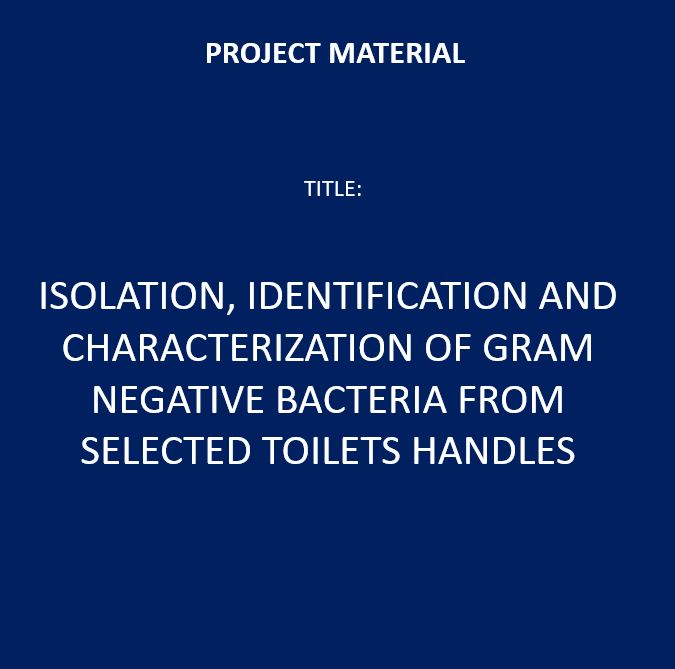No products in the cart.
Isolation, Identification and Characterization of Gram Negative Bacteria From Selected Toilets Handles
₦10,150.00
ISOLATION, IDENTIFICATION AND CHARACTERIZATION OF GRAM NEGATIVE BACTERIA FROM SELECTED TOILETS HANDLES
- PROJECT YEAR: TT
- NUMBER OF PAGES: 26
- CHAPTER 1 TO 5
INTRODUCTION
Bacteria and fungi which are micro organisms and found everywhere and contaminate the body, houses, work places, and whole environment .Fortunately among many billion of bacteria, only 1500 can be dangerous for our health, causing different disease such as pneumonia or skin infection (Eltablawy and Elhinfnawi, 2009). These Microorganisms constitute a major part of every ecosystem. They live either freely or as parasites in these environments (Sleigh and Timbury, 1998).
The hand is can serve as a medium for the propagation of microorganisms from person to person and from place to place. Although it is nearly impossible for the hand to be free of microorganisms, the presence of pathogenic bacteria may lead to chronic or acute illness (Oranusi, 2013).
The risk of spreading of salmonella infection to other family members via the environment, including contaminated hands and surfaces in the toilet areas had been highlighted (Bloom field, 2000). As people come in contact with surfaces as desks, keyboards and office furniture, toilet lock handles, there is possibility of picking up microbes deposited on them. The toilet and offices lock handles are contact more frequently with their users and visitors, especially public toilets and offices. The hazards associated with toilet facilities office furniture and other formites had been established but less attention had been directed to toilets and offices lock handles as inanimate objects which could harbor and transmit infectious agents (Amala, 2015).
Human hands usually harbor microorganisms both as part of body normal flora as well as transient microbes contacted from the environment (Lindberg, 2004).
In polytechnic environment, students have access to service offices regularly for different purposes. It implies that the door handles are not routinely disinfected, the opportunity for the transmission of contaminating microorganisms is great and on the high side. Although it is accepted that the infection risk in general community is less than that associated with patients in hospital (Scott et al., 1982). The increasing incidence of epidemic outbreaks of certain diseases and its rate of spread from one community to the other has become a major public health concern (Nworie et al., 2012).
Many people believe that microbes are only present in research laboratories or in hospitals and clinics and thus they have a misleading feeling of security in other places. This is due to the lack of knowledge about where bacteria cause the health problem. It was considered by researchers that 80% of infections are spread through hands contact with hands or other objects (Al-Ghamdi et al., 2011). The main reasons are difficulties to prevent the transfer of microbes that are already present in human bodies (Lues and Tonder, 2007). Washing of hands is fundamental cautionary measure to protect against the spread of diseases and it is one of the primary practices to reduce the transfer of bacteria from person to person, or from person to food contact surfaces (Chinakwe et al., 2012). It is established that unwashed hands can transmit pathogens, especially fecal pathogens, to food product after visit to the toilet. Investigation of food borne illness showed that poor personal hygiene; primarily ineffective hand washing is an important contributor to food borne illness (Lambrechts et al., 2014).
No product has been found!
